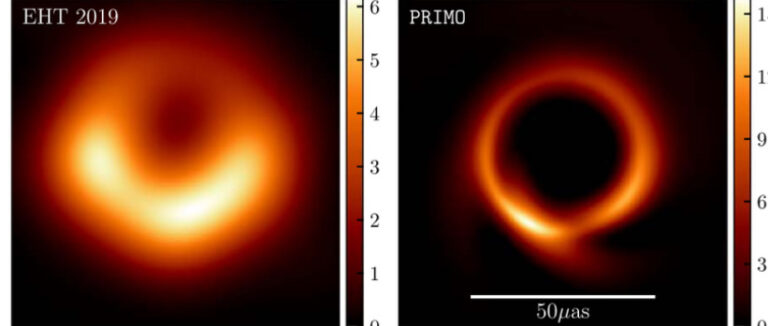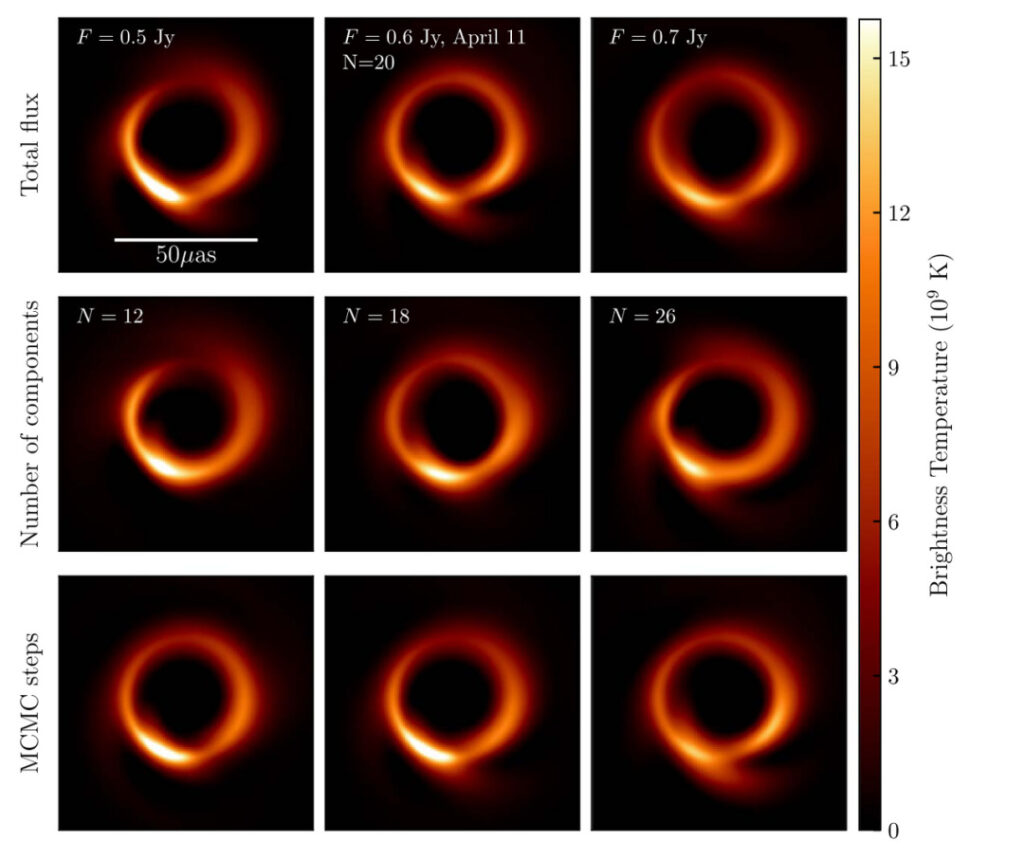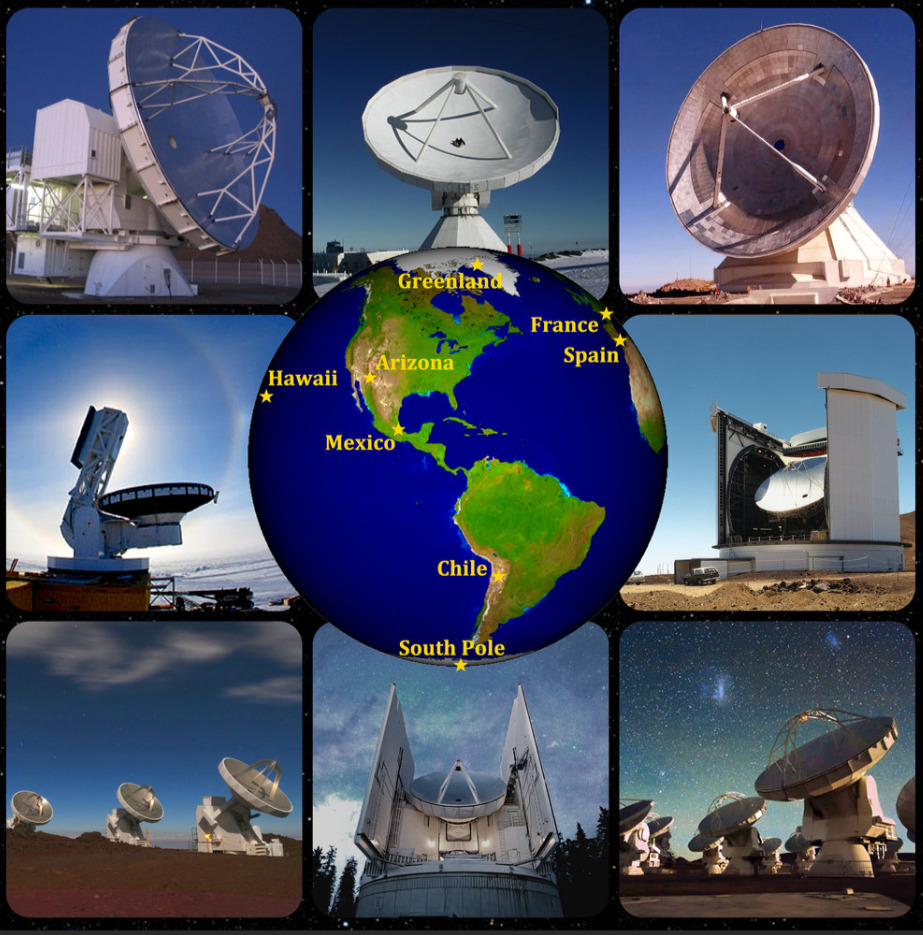Using PRIMO to Reconstruct the Image of the M87 Black Hole, the Princeton Institute for Advanced Study Successfully Transformed the "donut" Into a "golden Ring"

Contents at a glance:In 2019, the global research team of the Event Horizon Telescope (EHT) released the first black hole photo in human history. Due to the observation conditions at the time, this black hole image only showed a blurry outline. Recently, a paper on the reconstruction of the M87 black hole image based on the PRIMO algorithm was published in the astrophysics journal The Astrophysical Journal Letters. The research results brought a clearer black hole image.
Keywords:M87 Black Hole PRIMO Algorithm PCA
This article was first published on HyperAI WeChat public platform~
A black hole is a celestial body that exists in the universe in modern general relativity. Its gravity is so strong that the escape velocity within the event horizon is greater than the speed of light, so it is called a black hole. The M87 black hole is a huge celestial body 55 million light-years away from Earth.Its mass is about 6.5 billion times that of the Sun.
In 2019, the global research team of the Event Horizon Telescope (EHT) officially released the first black hole photo captured by humans - the M87 black hole photo. This was the first time that humans witnessed the true appearance of a black hole, making the M87 black hole "popular" overnight around the world.However, due to the limitations of observation conditions, the first image of a black hole could only present a blurry outline.
Recently,Researchers from the Institute for Advanced Study used more than 30,000 high-resolution simulated black hole images to train the PRIMO (principal-component interferometric modeling) algorithm.By learning the laws of light propagation around black holes, PRIMO can reconstruct higher quality and clearer black hole images. PRIMO enables scientists to study black holes more deeply and understand their properties and characteristics. It also provides a new type of data processing method, which brings great potential for the future development of astronomy and physics.The research has been published in the journal The Astrophysical Journal Letters, titled “The Image of the M87 Black Hole Reconstructed with PRIMO.”

The results have been published in The Astrophysical Journal Letters
Paper address:
https://iopscience.iop.org/article/10.3847/2041-8213/acc32d/pdf
From "Donuts" to "Golden Rings"
In 2017, EHT successfully took a photo of the M87 black hole using a radio telescope with an aperture equivalent to the diameter of the Earth.The photo shows that M87 looks like a "donut", with a bright ring outside and a shadow in the middle.

Figure 1: Image of the M87 black hole
Left: A photo of the M87 black hole taken by the Event Horizon Telescope in 2017.
Middle: Reconstruction results of the 2017 M87 data using the PRIMO algorithm.
Right: Blurring the PRIMO image to the resolution of the EHT array.
Figure 1 shows that compared to the first photo of the M87 black hole, the width of the reconstructed image ring has shrunk by half, and a larger, darker area has been exposed in the middle, more like a "golden ring". This shows that the researchers have successfully improved the resolution of the black hole image, and the image is consistent with the EHT data and theoretical expectations. In this regard, Lia Medeiros, the first author of this paper, said,"This research advance is of great significance for a deeper understanding of black hole behavior, as well as for theoretical model verification and gravitational testing."
Experimental procedures
Process Overview
The researchers used EHT's observation data of the M87 black hole on April 5, 6, 10 and 11, 2017 as the training set for this study.The observations were made from seven radio telescope sites at five geographical locations.Among them, the observation data on April 11 is the benchmark data set.
In this experiment,The researchers mainly used a novel image reconstruction algorithm, PRIMO, to reconstruct the black hole image.First, the researchers used general relativistic magnetohydrodynamics (GRMHD) simulations to generate a large number of simulated images of black holes. Then, they used principal component analysis (PCA) to obtain a set of sparse orthogonal basis in the GRMHD simulated image library, which is also an example of dictionary learning. Finally, they used the PCA basis and the PRIMO algorithm to reconstruct the image from the sparse interferometer data.
* GRMHD:General Relativistic Magnetohydrodynamics (GRMHD) is a theoretical framework that combines general relativity and magnetohydrodynamics to describe the behavior of matter and energy under high-speed motion and strong magnetic field conditions. GRMHD has a wide range of applications, especially suitable for studying and simulating some extreme physical phenomena.Such as plasma flow around black holes, magnetic fluid behavior in interstellar space, and the formation and evolution of galaxies and galaxy clusters. Through GRMHD simulation, we can study important issues such as the accretion process of black holes, the generation of jets, and the mechanism of star formation in galaxies.
* PCA:Principal components analysis (PCA) is a method used for statistical analysis and simplification of data sets. It transforms possibly correlated variable observations into a set of linearly uncorrelated variable values through orthogonal transformation. These uncorrelated variables are called principal components. By applying PCA, researchers can simplify complex data sets into fewer principal components. PCA has wide applications in data dimensionality reduction, feature extraction, and data visualization.By using PCA, researchers can better understand the data and transform it into a form that is more easily interpretable and usable, thereby discovering hidden information and relationships in the data.
* PRIMO:PRIMO (principal-component interferometric modeling) is a new algorithm based on dictionary learning. Its core is the principal component interferometric modeling technology. It is trained on a large number of simulated black hole images.Enables researchers to recover high-fidelity images in situations where radio telescope coverage is sparse,And achieve the physical resolution of the EHT array to address the data sparsity problem in millimeter-wave interferometry.
Parameter study
The researchers conducted a parameter study in this experiment.Parametric studies involve varying and adjusting the parameters of a system or model in order to observe and understand their effects on system behavior and outcomes.Through this study, researchers can explore the extent to which parameters affect various variables and output results during the experiment, as well as the relationship between the parameters.
The researchers set the total compact source flux of the M87 benchmark PRIMO image to 0.6 Jy and reconstructed the image using a linear combination of 20 PCA components. In the parameter study, the researchers compared the benchmark image with images obtained using different total compact source fluxes and different PCA components.Used to observe changes in image features.Such as the size of the ring, brightness, and the angle of the brightest point. The results are shown in the figure below:

Figure 2: Comparison of baseline image and images with different flux and PCA components
Top: Comparison of maximum a posteriori PRIMO images for total fluxes of 0.5, 0.6, and 0.7 Jy.
Middle: Comparison of maximum a posteriori images using only 12, 14, and 18 PCA components.
Bottom: Example images randomly drawn from the MCMC step of the benchmark chain, with a flux of 0.6 Jy and 20 PCA components.
As can be seen in the figure,Different total compression source fluxes and different numbers of PCA components will result in differences in the brightness and position angle of the brightest part of the ring.At the same time, the size and width of the ring are not affected. Figure 3 shows a comparison of images reconstructed based on EHT data from April 5, 6, 10 and 11, 2017.

Figure 3: Comparison of images reconstructed from EHT data on April 5, 6, 10 and 11, 2017
As can be seen in the figure, the position angle of the brightest part of the ring and the brightest part in the southern part of the ring vary slightly on different dates. By comparing the images of the first two days and the last two days, we can also clearly see the difference in the position angle of the brightest part of the ring and the brightness of the ring.The researchers believe this is due to the observed source structure, which is the difference in the distribution and arrangement of matter around the black hole.
The first author of the paper was interviewed and detailed the impact of PRIMO on astronomy
April 14, 2023The Discovery Files Podcast interviewed Lia Medeiros, the first author of this paper.
In the interview, Lia Medeiros said that theoretically, the telescope for observing black holes should be as big as the earth, but due to practical reasons, humans cannot build such a huge telescope.So there is the EHT array, which consists of multiple radio telescopes around the world.Using a technique called interferometry, a virtual telescope with an aperture equivalent to the diameter of the Earth is formed to observe black holes.

Figure 5: Black hole image generated by EHT (by Andrew Chael)
At the same time, Lia Medeiros also introduced that the original aperture color in the black hole image is invisible to the human eye, so it is impossible to show everyone the true color, and the researchers chose orange to represent it because this color has aesthetic appeal. And,The light does not come from the black hole itself, but is emitted by the matter surrounding the black hole.
This article was first published on HyperAI WeChat public platform~
-- over--